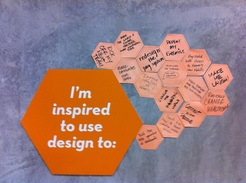|
Day 2 of the bootcamp was all about ideation and testing. We brainstormed a ton of ideas, voted, went through an excruciatingly painful but educational process of narrowing and deciding, and then whirred through several prototypes, killed half our designs and coming to something simple and focused by the end. It was an awesome day working with our hands, moving our feet, and testing physical, tangible versions of our ideas (which were service-oriented) on real people. Whoa.
The day concluded with an awesome panel talking about bringing design thinking back to their organization (large and small). Below are some of my most memorable takeaways from the day's activities and the panel. Ideation i. HMW questions: how might we 1. Break up POVs into mini-brainstorms w/ HMWs ii. IDEO brainstorming rules iii. Space makes a difference 1. No table 2. Big whiteboards 3. Standing 4. Lots of space 5. Post-its onto whiteboard iv. “to build on that” i. Stoking/getting revved up for brainstorming i. Rock paper scissors tournament game j. Brainstorm voting using 3 selection criteria i. Most likely to succeed ii. Most likely to delight iii. Most likely to be breakthrough k. Everyone puts 2 of each of 3 color stickers on idea post-its to vote l. Cluster ideas + pick those w/ high votes (hard!) Prototype i. Cycles = greatness ii. Don’t get ready, get started iii. Bring prototype to meeting, have it absorb emotional trauma (not you) iv. Don’t do sales on the prototype w/ user v. Show don’t tell; have user tell you vi. Ask for the negative stuff up front. When prototype breaks, it’s when you learn Testing i. Not: 1. Leading the witness 2. Guarding your prototype 3. telling ii. Hot: 1. Ask open ended questions 2. Letting go of prototype 3. Show Testing debrief 1. Prototype: + (like), delta (change), lightbulb (idea) 2. Test: + (like), delta (change), lightbulb (idea) iv. Feel exhausted, but good exhausted Group Debrief ii. class as prototype iii. build in culture of feedback at work iv. “I like, I wish” v. How can I view all of life and work as a continuous prototype? ix. Use sharpies + post-its so you can read from distance Panel on organizations 3. Lots of market research/small group panels bad 4. Step 1: start with yourself a. Read books: Change by Design, Business of Design, Do You Matter b. IDEO c. Prototyping is messy, had to accept it 5. Step 2: small teams, one a time a. Teaching to know 6. Step 3: go to global org a. Stanford b. Trained facilitators iii. Responsible for experience, not equipment iv. Make your users be your designers; User Advisory Board x. Not acceptable to do quarter to quarter incremental change v. Process/empathy meetings w/ everyone so all can learn what everyone else does vi. Most of issues not technology vii. Design thinking for service iv. Build social network in your company one by one of DTs v. Building innovation lab, cross-disciplinary team viii. Innovation is everyone’s responsibility, not a secret club ix. Avoiding organ rejection v. principles 1. Make it simple 2. Exhibit craftsmanship 3. Inspire delight 4. Deliver unique value 5. Focus on goals viii. CEO commitment ix. Dt applies across departments including finance, HR, etc. x. Everyone has role in making design matter iii. d.school space explicitly gives permission to make, go wild iv. Start bringing in prototyping materials, playdoh, legos, pink chair v. Told people about dt by rephrasing in other’s context vi. Did secret project using dt vii. Transform space, cube viii. Gift giving then real projects ix. Use “secret viral” if in your culture w. How to scale dt champion i. Work directly w/ teams to inspire others x. How to create right space i. Tear down cubicles, create foam core movable project spaces y. How to measure ROI of dt i. Catalog success stories ii. Design as driving value Day 2 themes, takeaways i. Having champions ii. Don’t ask for permission iii. Cultural inertia is common iv. Keep the momentum, dive in fast v. Know own culture vi. Scaling: crank up hot emotions, not rational argument to scale change 1. Hot cause, cool solution vii. Teach experientially, not PPT viii. Self -> team -> org ix. Design for extreme user to find inspiration x. Demos to teach, not lectures xii. Make a 6 word story of what you learned
1 Comment
7/18/2013 09:37:07 pm
Stanford university is one of the most prestigious universities all over and these videos and lessons given here from Stanford was really informative and I really enjoyed all sought of designing works briefed here. Keep posting more of these sought of informative educational lessons in future also.
Reply
Your comment will be posted after it is approved.
Leave a Reply. |
Archives
June 2024
Categories
All
Subscribe |

 RSS Feed
RSS Feed
